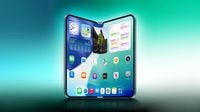Apple is once again making headlines, not just for its latest devices but for the way it manages the lifecycle of its products and teases the next wave of technological innovation. On October 5, 2025, Apple officially updated its product support policies, marking a significant shift for millions of device owners worldwide. At the same time, leaks and regulatory filings have offered a tantalizing glimpse into Apple’s near future—one that promises foldable phones, cutting-edge tablets, and powerful laptops.
For loyal Apple users, the recent update to the company’s “vintage” and “obsolete” device list is both a sign of the relentless pace of tech evolution and a reminder that even beloved gadgets have a shelf life. According to VOV.VN, Apple has reaffirmed its commitment to support iPhone products for at least five years after they are discontinued from sale. After that, devices enter the “vintage” category—a status that brings both limitations and, for some, a touch of nostalgia.
This week, Apple added the iPhone 11 Pro Max and all Apple Watch Series 3 models to the vintage list. This follows a similar move in May 2025, when the company classified the iPhone 7 Plus and select iPhone 8 models as vintage. But what does this mean for those still clutching their trusty devices?
Apple defines a product as “vintage” if it has not been sold for more than five years but less than seven. These devices may still function perfectly well, and, in some cases, continue to receive critical iOS updates—particularly those addressing security vulnerabilities or urgent bug fixes. However, Apple no longer guarantees repair support at its stores or through authorized service providers. As the company puts it, “A product is considered vintage when it has stopped selling for more than five years but less than seven years.”
Interestingly, not all devices from the same generation receive the vintage label at the same time. For example, the iPhone 11 Pro remains off the vintage list because it was sold for a longer period than the iPhone 11 Pro Max. It’s a subtle distinction, but one that matters for those seeking repair or support.
The story doesn’t end there. Once a device surpasses the seven-year mark since its last sale, it is reclassified as “obsolete.” At this point, hardware support is generally discontinued—though there’s a notable exception for MacBook batteries, which can be replaced for up to ten years after the product’s final sale. Even so, Apple sometimes continues to issue security patches for certain obsolete devices, as seen with the iPhone 6S. This policy, while frustrating for some who rely on older tech, reflects the rapid pace of hardware and software advancement. Maintaining support for aging devices has become a formidable challenge.
Still, vintage doesn’t necessarily mean the end of the road. Many independent repair shops continue to offer services for these devices, even after Apple’s official support ceases. As VOV.VN notes, “Independent repair shops may continue supporting vintage devices even after Apple stops official repairs.” For users determined to keep their devices running, this can be a lifeline—though sourcing parts may become increasingly tricky as the years go by.
While Apple is managing the twilight years of some of its most popular products, it’s also gearing up for a new era of innovation. Reliable sources reported on October 5, 2025, that Apple is preparing to launch its first foldable iPhone as early as 2026. This long-rumored device is expected to feature a book-like design, a robust titanium frame, and a nearly invisible curved screen, according to information from Bloomberg’s Mark Gurman and analyst Ming-Chi Kuo.
The details emerging from these leaks are nothing short of intriguing. The foldable iPhone is said to measure 9 to 9.5 millimeters thick when folded, slimming down to just 4.5 to 4.8 millimeters when open. Its outer screen will reportedly have a diagonal of 5.5 inches, while the inner display will stretch to 7.8 inches—essentially transforming the device into a mini iPad when unfolded. The inner screen is expected to boast a resolution of approximately 2713 x 1920 pixels (with a 4:3 aspect ratio), and the outer screen will offer about 2088 x 1422 pixels.
Apple’s engineers are said to be using a special metallic reinforcement layer to distribute bending forces, reducing the risk of visible creases—a common complaint with current foldable phones. The frame will be crafted from titanium, while the hinge will combine titanium and stainless steel. There are even plans to use a “liquid metal” alloy produced by pressure casting, further increasing durability and minimizing potential screen imperfections.
But the foldable iPhone isn’t the only new hardware on Apple’s horizon. Leaked documents from the U.S. Federal Communications Commission (FCC) in early October 2025 have confirmed the imminent arrival of several new Apple devices. Among them: a MacBook Pro powered by Apple’s next-generation M5 chip (model A3434) and a family of new iPad Pro models, all supporting the latest Wi-Fi 7 standard. The FCC filings, which typically surface just weeks before official launches, suggest these products will be hitting store shelves before the end of the year.
The iPad Pro lineup is expected to include both 11-inch and 13-inch models, with variants for Wi-Fi-only and cellular connectivity. While the new iPad Pros are confirmed to support Wi-Fi 7, it remains unclear whether the MacBook Pro M5 will feature the same wireless technology—Apple may be taking a more gradual approach to rolling out Wi-Fi 7 across its laptop range. Additional leaks, including a YouTube unboxing video of the iPad Pro M5, all but confirm that the tablet’s debut is just around the corner.
Taken together, these developments signal a major shift in Apple’s hardware ecosystem. The company is simultaneously winding down support for devices that once defined the smartphone and wearable market, while preparing to unleash a new generation of products that could fundamentally reshape user expectations. For consumers, this means facing tough decisions: stick with a trusty, now-vintage device and navigate dwindling support, or leap into the future with Apple’s latest innovations.
One thing’s for sure—whether it’s managing the legacy of the iPhone 11 Pro Max or anticipating the arrival of a foldable iPhone, Apple continues to set the pace for the industry. The company’s ability to balance the past and the future, even as it lets go of some old favorites, keeps both fans and skeptics watching closely. For those invested in the Apple ecosystem, the coming months promise to be anything but dull.




